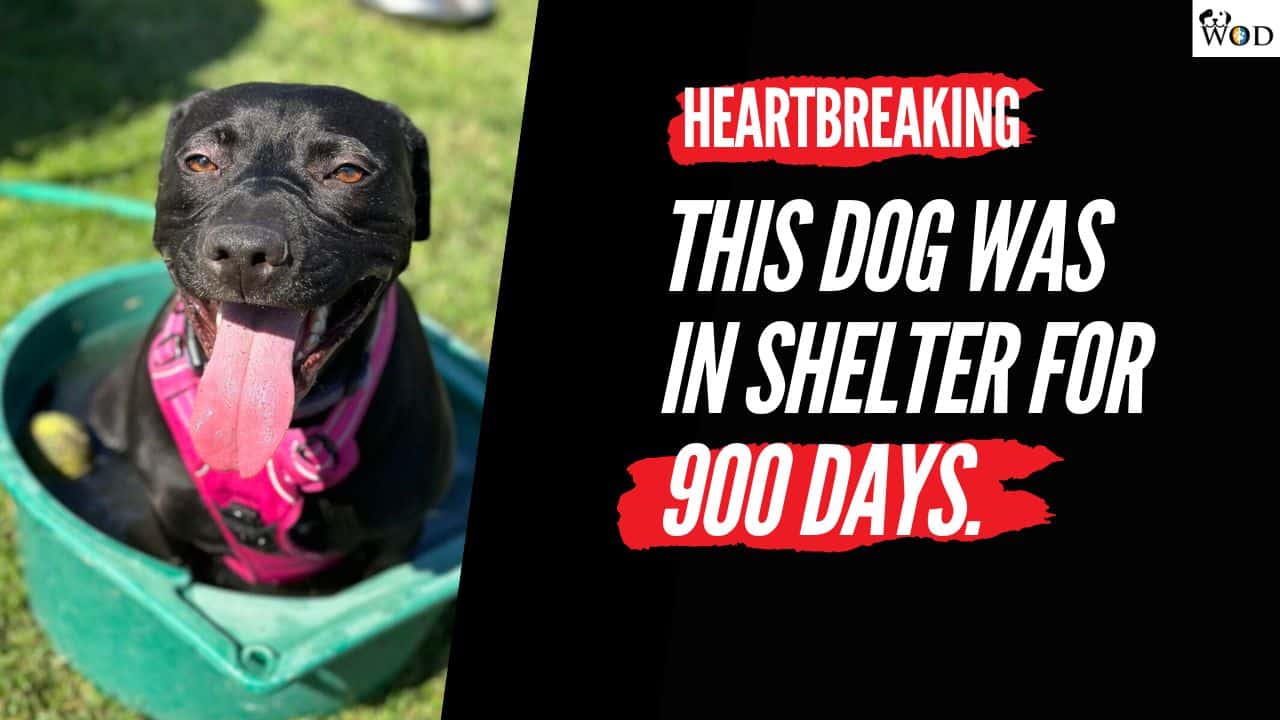Welcome to the fascinating world of German Shepherds, a breed renowned for its intelligence, loyalty, and versatility. But did you know that within this iconic breed lies a subtle yet significant distinction?
Yes, we’re talking about the difference between long-haired and short-haired German Shepherds. While they may share the same noble lineage, these two varieties exhibit unique characteristics that extend beyond the length of their fur.
The primary difference between long-haired and short-haired German Shepherds is their coat length. Long-haired types have a longer, silkier coat and lack an undercoat, while short-haired ones have a dense, double coat, better for various climates. Both varieties share similar temperaments and traits.
However, in the world of German Shepherds, the distinction between long-haired and short-haired varieties is more than skin deep – it’s a fundamental aspect that shapes their identity, presence, and the role they will play in your life.
In this blog, we’ll delve into the nuances that set these two types apart, from their distinct appearances to differences in grooming needs, temperament, and even health considerations.
Join us as we explore what makes each type special and help you discover which might be the perfect fit for your lifestyle and preferences.
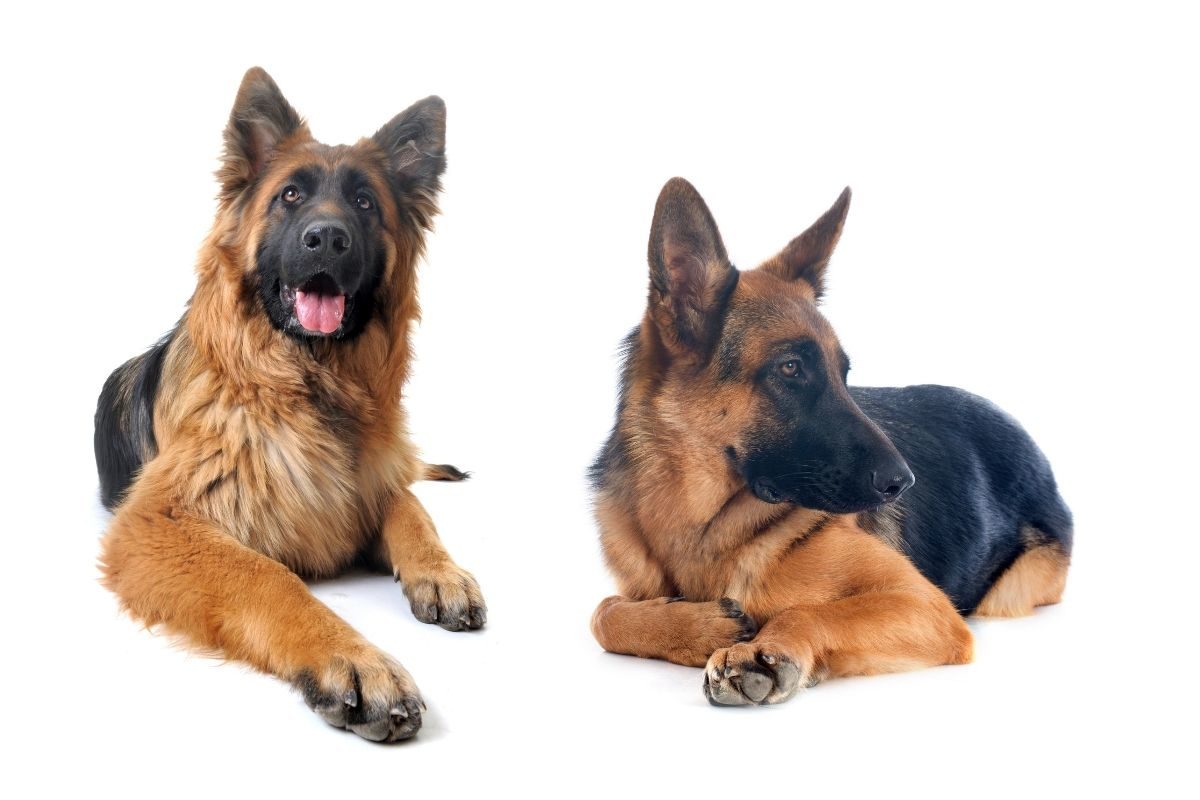
Difference Between Long Haired and Short Haired German Shepherds
Here’s a snapshot of the differences between the two varieties:
| Feature | Short Haired GSD | Long Haired GSD |
|---|---|---|
| Alternative Names | Stock*** coat, Short stock coat, Standard coat, Normal coat. | Long coat, Long stock coat, Long stock hair, “Coaties.” |
| Coat Length | Less than 1 inch long. | At least 2 inches long. |
| Coat Appearance | Dense topcoat, straight, coarse fur lying close to the body. Longer and thicker hair on the neck. Slightly longer fur on the rear of the forelegs and hind legs to the hock and pastern. | Soft topcoat, not close lying to the body. Feathering on the ears and legs. Longer and thicker hair on the neck, having the appearance of a mane. Hair is shiny and may form a parting along the back. |
| Coat Type | More expensive $1,500 – $4,000, depending on the bloodline. Higher stud value. | Mainly single-coated (open-coated). |
| Function | Companion pets, working-line or show-line. | Companion pets. The AKC views single-coated, silky hair or hair too long as faults for conformation. Short stock is the preferred working type. |
| Temperament | Intelligent, loyal, protective, high-energy, affectionate, brave, guard dog, working drive, athletic, confident, versatile, aloof, territorial. | Intelligent, loyal, protective, high-energy, affectionate, brave, guard dog, athletic, confident. Slightly more friendly due to a reduced working drive. |
| Shedding Rate | High shedding. Will shed all year round and more so in the spring and fall when the undercoat is shed. | High shedding but stays consistent all year round if open-coated. |
| Cost | More expensive, $1,500 – $4,000, depending on the bloodline. Higher stud value. | Less expensive $800 – $2,000. Lower stud value. |
***Stock refers to the breeding stock.
You can also check out our YouTube video here…
1. Hair Length and Appearance
The first difference between a long-haired German Shepherd and a short-haired German Shepherd is that the short coat has a topcoat with fur that doesn’t cross the one-inch mark.
On the other hand, long-haired types have a topcoat with hair length going beyond 2 inches. This creates a significant enough difference in appearance.
Short-haired German Shepherds have a short, dense topcoat, and the fur will be straight, rough, and lie close.
In contrast, long stock coats have longer fur, which is softer and not close fitting, with feathering on the ears and legs. The hair appears shiny and is longer and thicker on the neck, forming a mane.
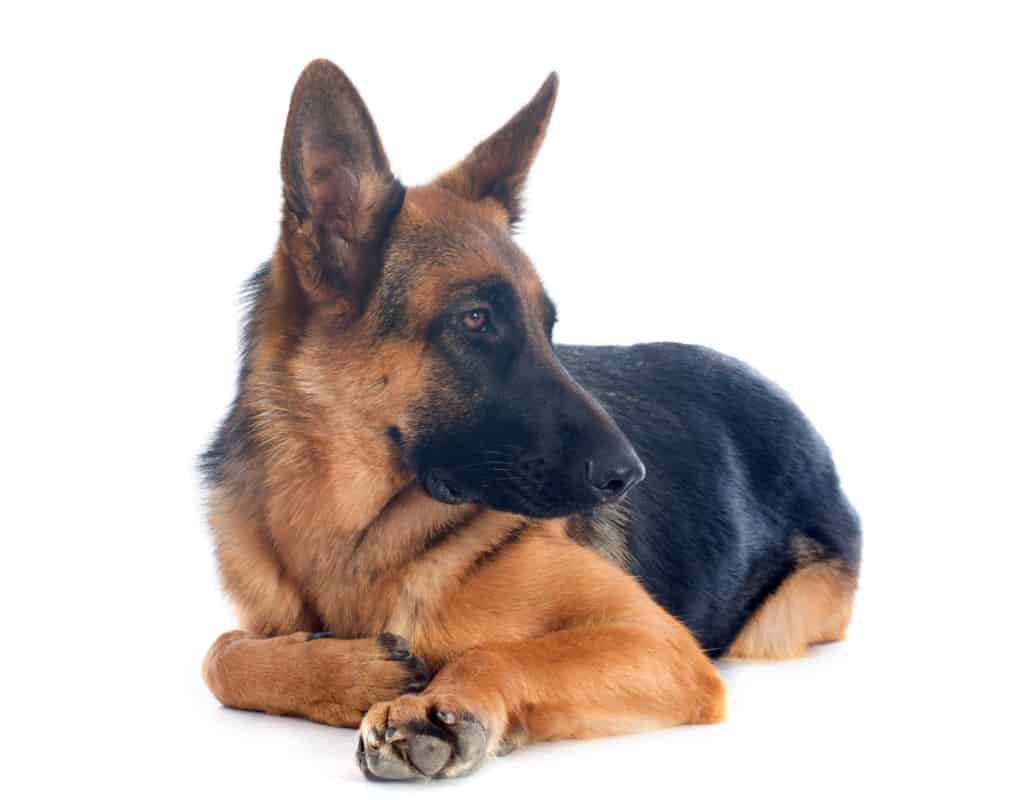
Long-haired varieties look more wolf-like. However, the sleekness of their topcoat, alongside the absence of an undercoat, can also make them look more fox-like.
On the other hand, a short-haired German Shepherd has the classic German Shepherd look because shorter coats set the breed standard.
If you have watched any movie with the breed, there’s an over 90% chance you’ve seen the short-haired German Shepherd. Consequently, your idea of the breed is similar to the short coat.
However, fur’s primary function isn’t for appearance or to expand on the choice of colors. It is to regulate your dog’s temperature and protect him from cold and heat. Surprisingly, both varieties don’t have contrasting temperature tolerance because of coat length.
2. Coat Type
While long-coat German Shepherds are closer to their wolf ancestors in terms of their fur length, the short-stock coats are closer in terms of coat quantity. Wolves have double coats, as do short-haired German Shepherds.
Long-haired types, however, often don’t have an undercoat. They are referred to as being open-coated.
The absence of the undercoat offsets the long hairs’ ability to trap heat. As a result, a long-haired German Shepherd’s coat can trap roughly the same amount of heat as double-coated dogs.
While there’s little temperature regulation impact due to coat quantity, there is a significant human-judgment impact. Working-line German Shepherds have to be compact and agile. Long dragging fur with no undercoat isn’t what most working-line breeders are looking for.
Read more: German Shepherd Coat (Types, Colors, & Patterns)
Even harsher is the judgment from the show crowd. The missing undercoat gets the long-haired German Shepherd disqualified from most dog shows, and their entire category is labeled a fault by the American Kennel Club.
I’m often asked whether long-haired German Shepherds are bigger.
So, what’s the deal?
Long-haired German Shepherds are not bigger than the short-haired variety. Although their long, silky fur and thick mane may make them look bigger, they are the same size as all other types.
Males are 24-26 inches tall and weigh 66-88 lbs, and females are 22-24 inches tall and weigh 49-71 lbs.
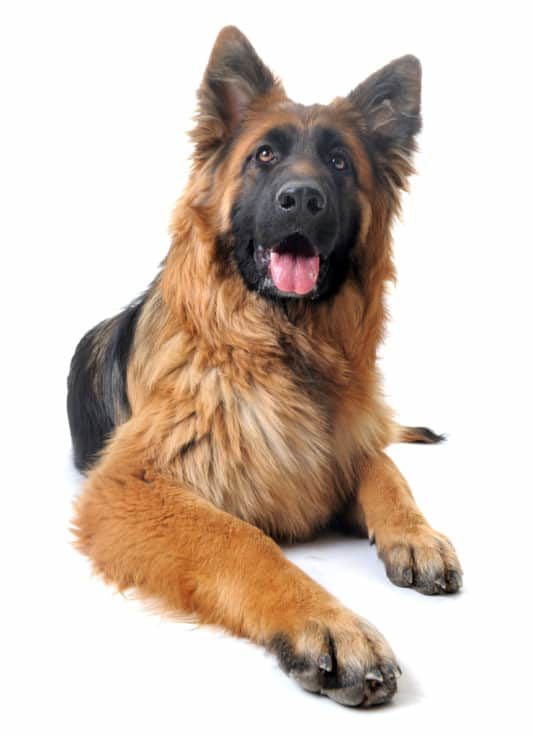
3. Shedding Rate
Both long-haired GSDs and short-haired German Shepherds shed hair faster than Facebook changes its algorithm. But does any particular type shed more?
Long-haired German Shepherds do not shed more than short-haired types, although the shedding rate varies throughout the year among short-haired GSDs.
This is because their undercoat is the source of a significant amount of shedding, and it sheds more during the spring and fall seasons.
Long-coated dogs usually have only the topcoat, which sheds at an even rate all year round. However, if a long-haired German Shepherd has a double coat (very rare), then his shedding rate will also vary throughout the year.
4. Work Acceptability
Both long-haired and short-haired German Shepherds make good family dogs. However, when it comes to taking puppies in as canine labor prospects, almost all the long-haired types are left out.
That’s because those who rely on serious canine work purchase working line dogs, and among working line breeders, a long-haired German Shepherd is seen as unmarketable.
Of course, that’s not to say that long-haired types cannot do any work; it is just that those who want dogs for work don’t buy them.
However, the reality is that they’re slightly inconvenient to use for work as their fur can get in the way and is harder to clean, and they don’t have as strong a working drive due to the breeding program.
5. Show Ring Acceptability
If you think working line criteria are harsh, wait to see how the show ring treats long-haired German Shepherds. Both types are seen as visually appealing by different people, but after all, beauty is subjective.
But if beauty is truly in the eye of the beholder, then the show ring judges seem to be entirely blind when it comes to long-haired German Shepherds.
They are not only seen as faulty because the missing undercoat disqualifies them from the show ring but even double-coated, long-haired ones get judged critically upon making it to the ring.
Nonetheless, this has a pleasant side effect. The lack of show ring acceptability ensures that those buying long-haired German Shepherds are not doing so in hopes of show circuit glory or rewards; they are doing so out of love.
Learn All About German Shepherds In This Video…
6. Temperament
Both the short-haired German Shepherd and long-haired varieties have almost equal temperaments. Some will claim that “coaties” are slightly friendlier, calmer, and less aggressive.
So, what’s the bottom line?
Long-haired German Shepherds are not less aggressive or calmer than the short-haired variety. There is no difference between the two.
However, they are known to have a slightly friendlier temperament due to not having a strong working drive, as most working lines are short-haired.
As far as aggression is concerned, there is often a misconception that German Shepherds are aggressive due to their appearance and resemblance to wolves.
However, with proper training and early socialization, they are a friendly and affectionate breed.
7. Cost
Short-haired German Shepherds cost more than long-haired ones because they are more versatile and widely accepted.
They have higher chances of qualifying in the show ring, so most show-line German Shepherd breeding is done with short hair in mind. They are also used as working lines.
If a long-haired German Shepherd is born in the show line, he becomes “useless” to the show circuit, and the fact that he wasn’t bred for work means he won’t be adopted for work either but will still thrive as a companion pet.
Such a dog is sold cheaper. A long-haired German Shepherd will cost between $800 – $2,000 (high-end) with papers.
Such a deal would be absurd for a short-haired type. On average, you would need $2,000 to get a decent short-haired puppy, and prices can go as high as $4,000 depending on bloodline and working drive.
Of course, you can do a wonderful thing and adopt a rescue for a far cheaper price.
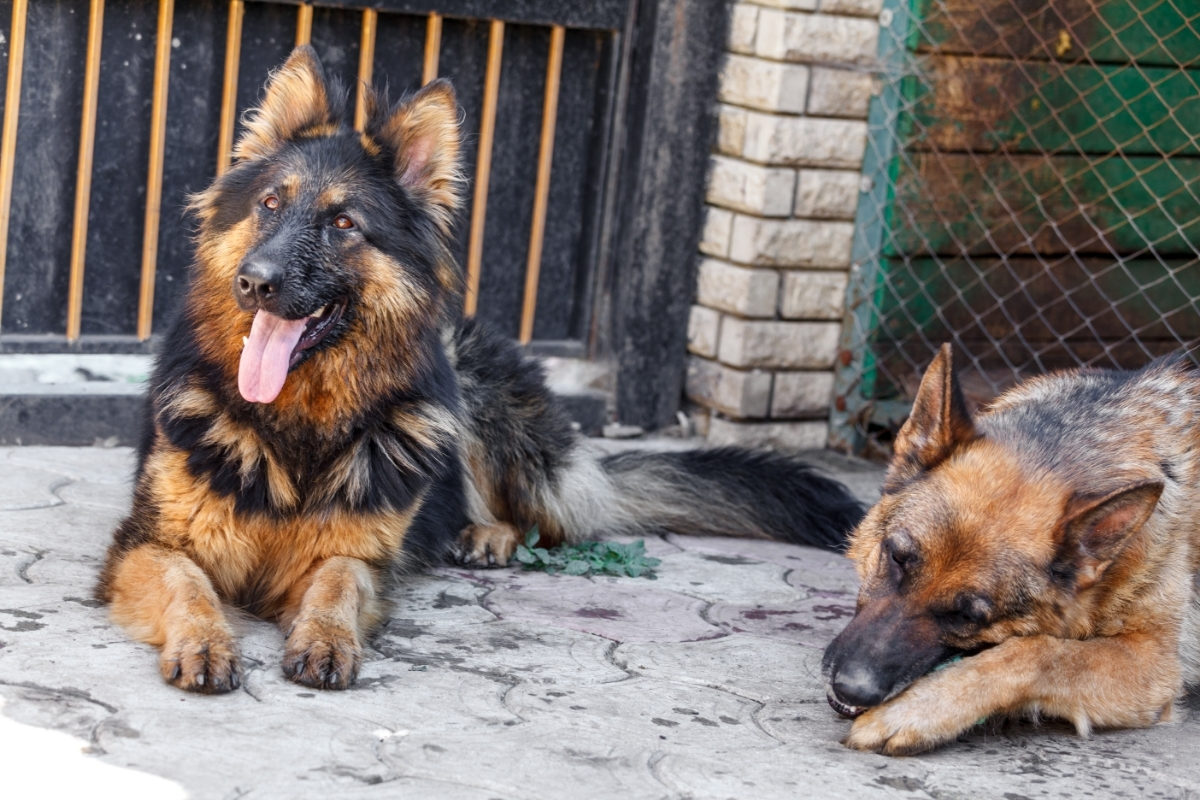
8. Stud Value
If one dog gives you a higher chance of getting a $800 puppy and one gives you better odds of getting a $2,000 puppy, who would you rather have? For most breeders, the answer is a short-haired GSD.
Coat variation is governed by gene variants. Long hair is a recessive trait, which means both alleles (gene halves) must correlate with long hair to have a long-haired puppy.
A short-haired German Shepherd might carry one long-hair gene half, and it will not show, but if the same dog mates with another who also has a dormant half gene of long hair, the two dormant genes might pair and form a full long-hair gene which would make the puppy long-haired.
And guess what happens when a short-haired stud produces a long-haired puppy? The short-haired parent is often removed from the stud pool.
If breeders remove short-haired studs with a 25% chance of producing a long-haired pup, it isn’t surprising that no mainstream breeder is interested in keeping a long-haired dog as a stud.
Because a long-haired German Shepherd has both gene halves representing the long-haired trait, his odds of producing a long-haired puppy are 50%. Having such a stud in a market where 50% of your puppies would get a 50% price cut isn’t a wise business move.
Which is Better for You – Long or Short Coat?
Now that you know the differences between the long-haired German Shepherd vs. the short-haired one, let’s look at which type is right for you.
To do so, I’ll mention the kind of dog owner for whom a long-haired GSD would be ideal and the one for whom the short-haired variety will be excellent.
Best for Dog Shows: Short-Haired
It is a myth that you cannot show a long-haired German Shepherd. However, it is primarily true because any dog with an absent undercoat is disqualified. Given that double coats in the long-haired variety are pretty rare, the general assumption stands true in most cases.
If you intend on entering your dog in a show, you should get a short-haired German Shepherd. Even so, you’ll need to ensure the dog is from a show line and has the right color. To learn more about which colors are considered faults, check out my post on German Shepherd colors.
Best for Upscale Suburbs: Long-Haired
If you live in an upscale neighborhood and don’t want your neighbors or the homeowners’ association having problems with your pet, a fluffier dog will likely present as non-threatening and cuddly.
Since upscale is a subjective term, here’s a better indicator: if purse dogs are trendy in your neighborhood, your big dog better be a long-haired German Shepherd.
The dog is also considered exotic because of its rareness and distinct looks. This has social currency not in dog show circles but in upscale suburbia.
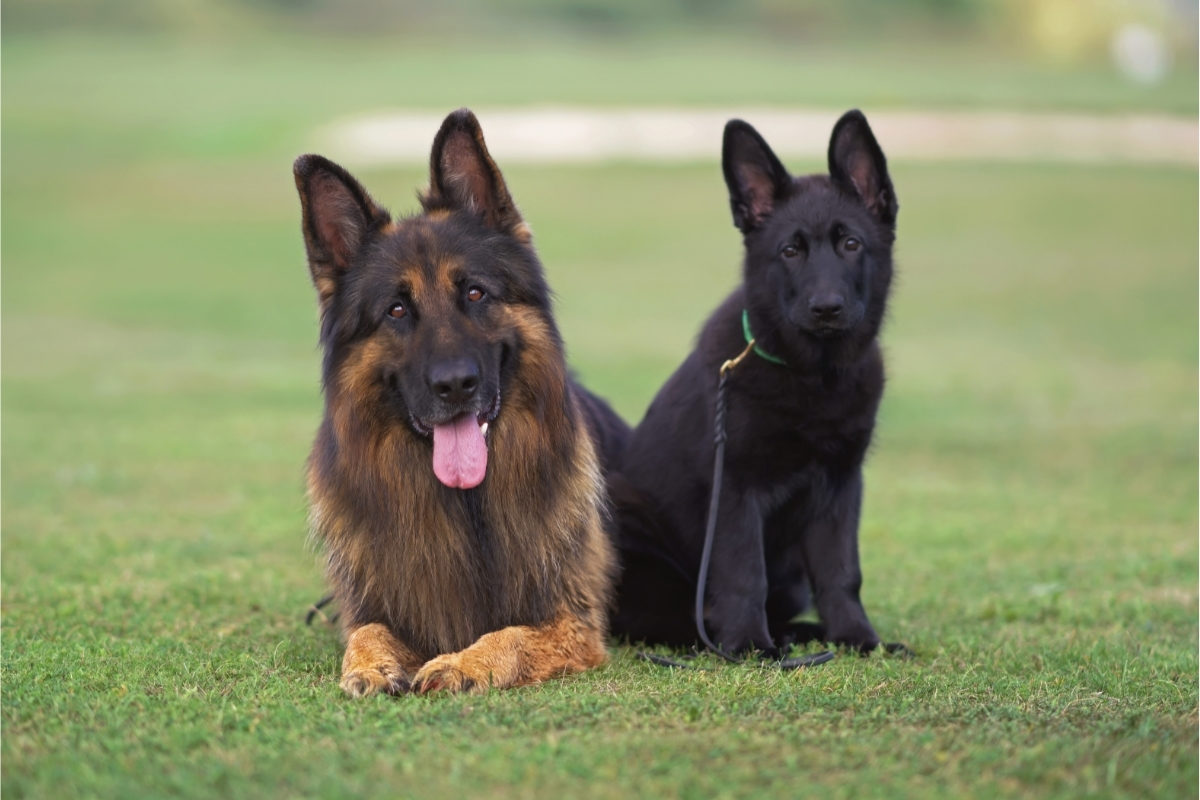
Best for Civilian Guard Duties: Long-Haired
Most institutions’ use of German Shepherds requires enrollment to comply with AKC standards. That’s why most K9 squads rely on short-haired dogs.
However, the long-haired ones are equally trainable and competent and, ironically, have a better look for the job. Color plays an important role here.
For example, a white long-haired German Shepherd looks cuddly and truly non-threatening. In contrast, a darker, long-haired doggo looks intimidating. If you have a house you want guarding, you’re better off getting a “coatie.”
Best for Institutional Service: Short-Haired
When it comes to teams, short-haired German Shepherds excel because of acceptability and enrollment criteria. It is safer to raise and train them because they are interchangeable between teams, squads, and institutions.
Long-haired GSDs trained for official work might get sidelined if a team is disassembled, as other team recruiters won’t accept them.
If you want to enroll even one dog but plan on having more in a pack to guard or serve a business, farm, or school, you should get a short-haired German Shepherd.
Best for Saving Money: Long-Haired
Given that long-haired types come considerably cheaper than short-haired German Shepherds, there’s an obvious short-term financial incentive to get a long stock coat.
It is also important to note that the long-haired type doesn’t lack anything significant in any area as far as owning and raising a family dog is concerned.
Still, the amount of money you save on this one-time transaction isn’t a significant enough advantage to offset the medical uncertainty of acquiring an untested dog.
Even when getting a long-haired German Shepherd, make sure to get one from a breeder who provides you with the parents’ health checks.
FAQs
Is one coat type more prone to health issues than the other?
There is no evidence to suggest that one coat type of German Shepherd (long or short hair) is more prone to health issues than the other. Both types can be prone to certain health issues, such as hip dysplasia and bloat, but these conditions are not specific to one coat type.
Can I show a long-haired GSD in AKC competitions?
Yes, long-haired German Shepherds can be shown in AKC competitions, but they will be disqualified if they have a white coat. The AKC breed standard allows for all colors and coat lengths except for white.
Do long-haired German Shepherds shed more than short-haired ones?
While long-haired German Shepherds shed continuously, short-haired varieties undergo seasonal shedding cycles. Both require regular grooming, but short-haired dogs may shed less overall.
Can I keep a long-haired German Shepherd in a warm climate?
It is possible to own a long-haired German Shepherd in warm climates so long as their coat is properly maintained. Frequent brushing, clipping, and limiting time outside in peak heat are recommended to keep them comfortable.
Final Thoughts
Short-haired German Shepherds are not too different from their long-haired counterparts. The “coaties” have longer topcoats with an often-missing undercoat.
However, this slight difference gets exaggerated because of variations in acceptability and judgment.
As things stand, you should get a short-haired German Shepherd if:
- You want a standard German Shepherd.
- You plan on showing, or you want a working dog.
- You want to use your dog as a stud.
And you should get a long-haired German Shepherd if:
- You have kids or neighbors with children and want a fluffy dog (white or liver).
- You want an exotic wolf-like German Shepherd (silver, gray, or brindle).
- You want a dark, intimidating dog to keep intruders away (black & tan, black & red, or all black).
Related Posts You May Like:





